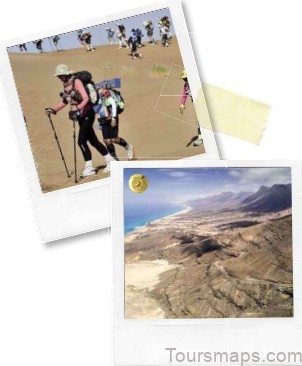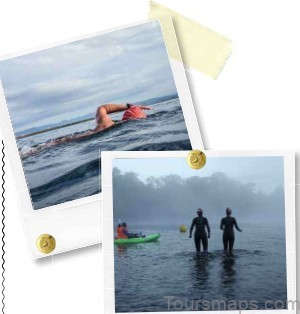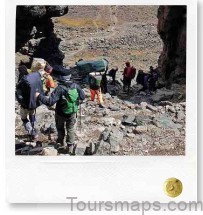Craving adventure but no time or money to tackle your ultimate challenge? It’s time for a mini-adventure…
Standing tip-toe on the edgeof a cliff on Cape Town’sTable Mountain, I tentativelylean backwards, heart inmouth, and surrender myweight to the coil of ropeI’m hoping will support meas I abseil down the continent’s iconiclandmark. It takes all the trust I can muster,but once over the precipice, I’m giddy withexcitement – the views are exhilarating.
The thrill of fulfilling a longed- for travel orfitness goal is amazing, and brings all kinds ofbenefits, including increased confidence, greaterendurance and a renewed enthusiasm for lifeBut what happens when you can’t afford thatonce-in-a-lifetime trip or don’t have time to putin the required training? There’s no need to giveup on your bucket list dreams – just break themdown into smaller, bite-sized pieces.
Want to go white water rafting in the GrandCanyon? France’s Gorge du Verdon is one ofEurope’s most beautiful canyons and has strikingturquoise water that makes water sports a visualfeast. Had a lifelong desire to dive the GreatBarrier Reef? Hone your skills in Ireland. Dontake our word for it, Jacques Cousteau oncesaid, ‘Some of the best diving in the world isthe northern side of the Dingle Peninsula, wherethe Atlantic Ocean meets the Brandon Mountainsin a landscape of exceptional beauty.’So when it comes to satisfying yourwanderlust spirit, think outsidethe box and you’ll have moreadventures, more of thetime. Read on for greatways to reimagine yourtop-bucket list items and fit them intoyour next longweekend!
Beat The Bucket Lıst Photo Gallery
The Run Marathon des Sables
Once you have a few marathons under your belt, it’sunderstandable that any bucket list contender has to be prettyspecial. For the ultra-tough ultrarunner, the 250km Marathon DesSables is up there with the best, but you have to be pretty seriousto even think of attempting it. The Sahara Desert location makes itarduous enough – think endless sand dunes, white-hot salt plainsand 50oC – and you have to carry your own food and equipmentfor the week, too. Even drinking water is rationed – if you exceedyour allocation, you get a time penalty. Ouch.

Make it bite sized: The good news?This year sees the introduction ofMarathon Des Sables light – akathe Half Marathon Des SablesFuerteventura. The 120km distance isjust under three marathons long, andyou can run it solo, with a partner oras part of a team of three or more.Four days of racing, three stages andin similar landscape to the originalrace, it’s a great way to experiencethe challenges of a desert run. Pricesfrom €990, including a bivouac tosleep in (and take home afterwards)plus carbon walking poles;marathondessables.com.

The walk Great Wall of China
It’s no surprise walking sections of this architectural wonder ison many people’s to-do list. An astonishing 13,170 miles long, the2,200-year-old Un World Heritage has a stunning array of scenery,from the beaches of Qinhuangdao, to the deep gorges and ruggedmountains around Beijing and a desert corridor between toweringpeaks at Jiayu Pass. Its wide ramparts, intact parapets and steepinclines attract hikers up for a challenge, but its historical andcultural significance is just as compelling.
Make it bite sized: If you’re lookingfor a long-distance trail closer tohome, check out 84-mile longHadrian’s Wall Path. Nearly 2,000years old, it’s nestled betweenNorthumberland National Park andthe North Penines and passes throughsome of the wildest and mostdramatic countryside in England.Another World Heritage site packedwith history, Roman settlements andforts dot the route, including the bestpreserved, Housestead, which comescomplete with barracks, hospital andeven flushable Roman toilets! Walkit under your own steam, or opt fora guided trip and have your luggagecarried ahead for you by localcompany Hadrian’s Wall Ltd, who willsort accommodation, too. Die-hardbackpacker? Opt to camp under thestars each night (the company willprovide the tent and set it up for you).From £95; hadrianswall.ltd.uk.
The mountain ascent
Kilimanjaro, Tanzania
If climbing’s your thing, you’ll probably want to scale the world’stallest free-standing mountain at some point. Especially as it takesyou through a vast range of habitats in a matter of days, fromgrasslands, tropical rainforests, alpine meadows, moorlands anddesert uplands to snow and ice. Despite being 5,895m above sealevel, the dormant volcano is relatively easy to ascend – as long asyou have average fitness levels and can adapt to the altitude, youdon’t even need specific climbing skills for many of the routes.The downside of all this, of course, is that it can get very busy,attracting up to 50,000 people a year.

Make it bite sized: Closer to home,the Italian Dolomites has a myriad ofroutes suitable for seasoned climbersas well as beginners. The palelimestone peaks that soar 3,000mabove the Alpine meadows and rollinggreen pastures below are a rock-climber’s paradise. The Dolomitesalso has the highest concentrationof via ferrata in the world. These ‘ironpaths’ give novices access to strikingsummits normally reserved formountaineers, and you’ll definitelyfeel an adrenaline rush as you scalerugged crags attached to a networkof wire cables, ascend vertical rockfaces on steel ladders and crossunlikely suspension bridges at greatheight. But any nerves you feel willpale in significance when you take inthe stunning surroundings. Try viaferrata with Dolomite Mountains (from€1,620 a week), or climb routesdevised by women pioneers (from€1,280 for two days);dolomitemountains.com.

The Swim The English Channel
Every long-distance swimmer wonders what it would be like totake on the Channel – if they have the strength, commitment anddetermination. There’s no doubt it’s hard work; currents aside, thewater is cold – 13 to 19oC – and you’ll be swimming for anythingfrom 10 to 24 hours. But the good news is, a positive attitude willtake you far. According to the Channel Swimming Association,‘Ability is one half of the success; total determination and the rightmental attitude is the other half’. And when you think of the senseof achievement at the end of it…
Make it bite sized: If you’re up for aserious open-water challenge, but notready for the Channel, swimming thelength of Lake Windermere will giveyou a good feel for long-distanceswimming. In fact, it’s often part of awould-be Channel swimmer’s training.At 10.5 miles, it’s the longest lakein England and has much prettierscenery than the Channel! If the watertemperature is 18oC or below, wear awetsuit; it not only keeps you warmerbut makes you more bouyant, too, andit’s a good idea to have canoe supportso boat-users can easily see you. Atthe very least, wear a bright swimcap and tow float, and swim closeto the shores. Want to push yourselffurther? Pit yourself against othersat Swim Windermere One Way (10miles); sientries.co.uk, or the GreatNorth Swim (250m-10K); greatrun.org/great-swim/great-north-swim.
Ilike sports. A lot. Some people would arguethat my devotion to them borders onobsessive. But when I found myself grippingthe first ladder of a via ferrata course, neartears and shaking, I realised something –I don’t like high-risk sports. Downhill mountainbiking, off-piste skiing, horse riding, skydiving, multi-pitch climbing, free diving, whitewater rafting, motorsports – I’ll admit that I’ve spentmy life and career as a fitness writer avoiding theseactivities. At a push, you might catch me runningdown a fell but, even then, I’d be doing it withcaution. I, it seems, am not an adrenaline junkie.It’s not that I don’t want to like theseactivities (I’d love to freewheel my mountainbike down a gritty gradient with the samegusto as my husband), I’m just not usedto doing them. And that, according toProfessor Andy Lane, sports psychologistat The Centre for Health & HumanPerformance (CHHP.com), is the problem.‘As you get older, you become moreself-preserving and realise that the gain,rush and sense of achievement you getfrom a risky sport is lower than your fear ofbeing injured. It doesn’t seem worth it,’ heexplains. ‘But if you’re exposed to thesesports as a kid, you see everyone elsedoing them and think “I can do that, too”.’
YOU CAN DO IT!
Unfortunately, data shows it’s distinctlypossible that us girls were warned againstdoing risky sports as children. One2015 study in the Journal of PediatricPsychology reports that parents are fourtimes more likely to tell girls than boys to‘be careful’. And we may be more warythan boys of doing anything that comeswith a hint of danger. Another study fromthe University of Guelph in Canada showsthat boys are more likely to take a riskbecause they attribute injuries to “badluck”, and are more optimistic aboutthe activity’s outcome.But can we build the courage to try gutsysports? Good news – according to theexperts, it’s possible. All that’s requiredis the will to try and a crowd of helpers.‘If you have a good instructor and a groupof people who are supportive of yourefforts, you’ll be able to take on morethan you’d ever think possible,’ saysLane. It helps to learn about theactivity and have a positive role model,someone doing the sport successfullywithout coming to harm.Dr Tracey Devonport, sports andexercise psychologist at the University ofWolverhampton backs this up. ‘Researchsuggests that a greater familiarity with therisks associated with the sport is generallylinked to better risk management andreduced risk perception,’ she says.
TAKE SMALL STEPS
That’s not to say you should throw yourselfin at the deep end. If you take skiing as anexample, the best place to start is ona small slope. ‘The skills are the same,’explains Lane. ‘You’ll learn to balance, togo down the slope and to traverse acrossthe snow. Next, you’ll try doing it quicklyand, eventually, you’ll progress to a steeperslope.’ Of course, some people will gofrom beginner to expert in a flash – andpersonality does come into it. Data inthe journal Research Quarterly forExercise and Sport revealsthose who aremore impulsive, hedonistic andare most likely to be greater
WATCH AND
The smart among us follow anIf you’re taking on a dangerousbeing guided by an expert willconfidence. ‘People learn byothers,’ says Lane. ‘It mightconscious process but the thoughtcan do it, so can I” happenssomeone else succeed.’ Thisthe case when the risk becomesabout courage than actual abilityas when you’re at the top ofwith absolute confidence in yourskills. ‘This is when it helps tosomeone doing it and learn fromperson to gain the confidenceIt’s all a matter of how muchthink you have of the sport andyou believe the activity to be‘If we were asked to completeparachute jump, we would assessperceived demands and riskcombine our beliefs about the(“how likely is it that somethinghappen?”) and the possible outcomes(“how bad would that be?”, anticipated returns worth it?Davenport. ‘But receiving supportfrom others for the high-riskis positively influential.’ Turnseven if you’re scared thatsomething will go wrong,watching someone elseperform the activitysuccessfully could helpyou give it a go. And themore you see othersachieve the feat, themore confident youget. Read on todiscover howto boostyourbravery.
Table of Contents
Maybe You Like Them Too
- Explore Doncaster, United Kingdom with this detailed map
- Explore Arroyito, Argentina with this Detailed Map
- Explore Belin, Romania with this detailed map
- Explore Almudévar, Spain with this detailed map
- Explore Aguarón, Spain with this detailed map


